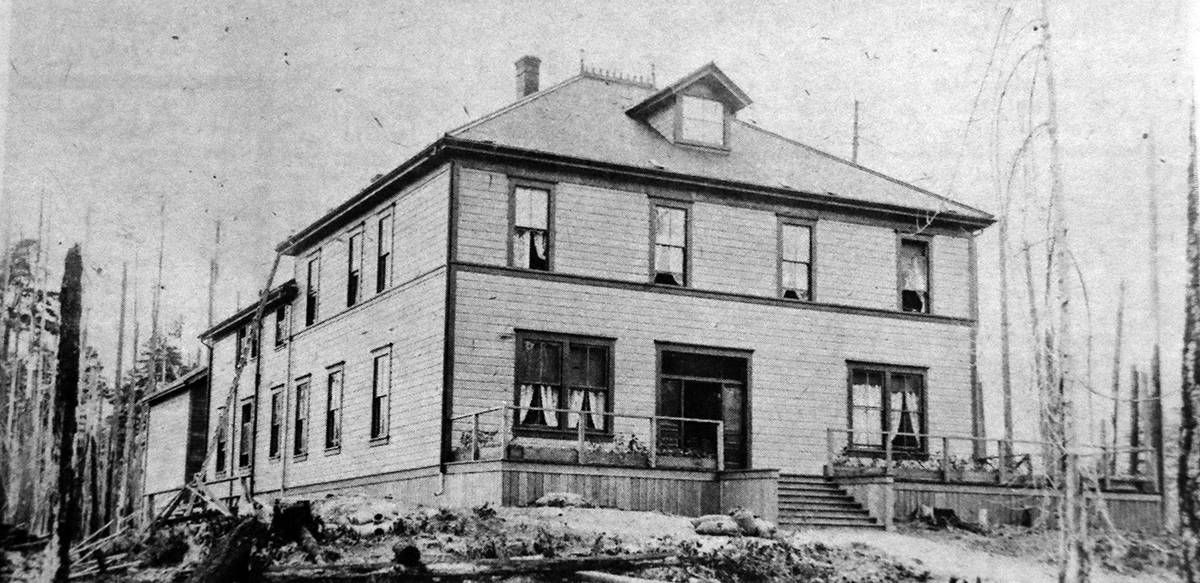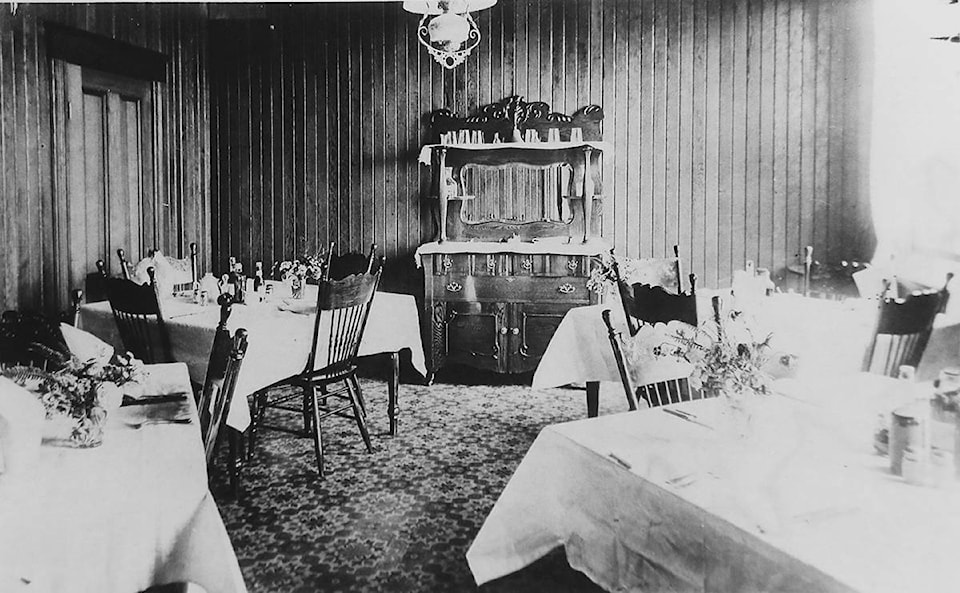“That old town makes me sad, somehow; it’s so lonely.”—P.M.C, 1932.
I’ve probably poked about Mount Sicker 100 times over the years. There’s not much to see now of the turn-of-the-last-century copper mining boom, thanks to repeated logging, road construction and outright vandalism. But, always, “The Hill,” as it was known to folks in Duncan during the mining excitement, calls me back to scavenge for artifacts and to take photos one more time…
What I’d give to be able to turn back the clock, if not to the height of the frenzied activity on this now deserted Westholme mountaintop — 200 mining claims, three working mines, two townsites, a railway, a tramline and an estimated 2,000 residents — then to the summer of 1932.
Why 87 years ago? That’s when someone who identified himself only as P.M.C. wrote an almost poetical account of his visit to the former ghosts towns of Lenora and Tyee for the Cowichan Leader. Under the headline, “The Old Mountain Road,” he describes many of the original buildings, in particular the Mount Sicker Hotel, as still standing, with bottles and other historical debris scattered about.
It’s enough to make a veteran bottle and antique collector gnash his teeth in envy!
Archival photos show entrepreneur Henry Croft’s hotel as having been a substantial and attractive hip-roofed structure, one with upstairs bedrooms, a polished bar and a dining room with lace tablecloths and, no doubt, real silver cutlery.
But, of course, all of this was long gone by the time I first visited the mountain in 1977. Like everyone else, I can only judge it by old photos.
So, today, I’m going to let P.M.C. take you on a gently edited eye-ball tour of the abandoned hotel and the Lenora and Tyee townsites as they were at the time of his visit. You can still pinpoint the site of the hotel, by the way, and find broken crockery, bricks, galvanized roofing and floor beams but everything’s now so hidden by new growth that it takes real imagination to believe that it ever was there. Nothing like in 1932 when the abandoned hotel topped a low knoll like a beacon. P.M.C. begins with his approach from the north…
“Just outside the gate is an old, old road which one time led to the old Mount Sicker mines and town. It is a steep and narrow old road, bordered with huge old Douglas firs and cedars which have looked down for many ages.
I wonder do they ever think of the hurry and bustle of that mining period — men journeying up, full of hope; returning, some with hope realized, others hopeless — families, storekeeper, doctor, padre, gambler, ladies of fortune, all that goes to make a mining town so busy until it peters out and is closed down and deserted…
It is a narrow, winding road, cut along the edge of the mountain, in some places out of the rock side, while on the other hand runs a deep ravine with the Chemainus River, out of sight but not earshot, a dull murmur or other times a roar as it cascades over rocks.
Stubby little trees grow along the side as the road gets steeper. Numerous little mountain streams with icy cold water cross the road, babbling away out of sight; the gorgeous maidenhair fern edges their beds. Occasionally we catch a glimpse of the old railroad bed down which ore was shipped, but except for a trestle or tie here and there, it is grown over with alders and young firs…
Still up, and the way steepens… We can see the Gulf and the islands stretched out before us, a few trails of black smoke from some ship, and Chemainus lumber mill; in the far distance the smoke of Vancouver, and beyond that the sun-tipped Coast Range dazzling in its snow-capped whiteness.
On again, while the road winds and gets even steeper. Trees hedge it in and the ground is damp. A rocky ledge on the right; on the left an opening — an old barn, roofless; two or three skeletons of houses, the verandas broken, windows gone, steps fallen to one side; a broken door, a few carved posts still upright — the beginnings of the old town. [This is Lenora townsite; we’re heading south.—TW].
Further on, we round a bend. Here stands the deserted hotel, centre of the town. Now the great double doors hang lopsidedly against the door-frame, the windows are broken, glass, rags, bottles and lumber are scattered round. Inside is a large hall and the remains of room partitions.
On the right is the barroom, with the counter standing crookedly against a wall. [It’s now in a Westholme home.] What stories it could tell of money, luck, joy, misery and forgetfulness purchased over its still polished top.
In the hall is a wide stairway with banisters [also rescued] gone. Upstairs all the flooring has gone. Higher still is the framework of another storey, a skylight still intact in the roof. Silence where once there was noise.
Out again to the remains of the veranda. Away in the distance rise line upon line of mountains, blue in their farness; a sheen of water between the hills; peace, except for the call of an eagle or croak of a frog; the distant murmur of the river; a retreat from worldly strife.
Down the steps and on. We reach the dismantled shed of one of the mines. [Probably the Key City.] Some machinery and a rusty bucket still hang over the shaft, and outside are great banks of refuse. Farther on we find more houses, some in great state still. Paper yet hangs on the walls. Then another mine [the Lenora], and we turn back, for the road ends.
Above on the left is another dismantled mine [the Tyee], from which an aerial railway carrying ore to the [E&N Railway] ran. Before us on the right are the old station and Chinatown.
Past the hotel and down another road stands a tumbledown building, the athletic club. A small house opposite was the doctor’s. A few drug bottles lie around, thimbleberry grows out of the floor and lichen crusts the walls. Among a few more tumbledown places is a heap of charcoal, scorched bedsteads, springs, pots and pans — the remains of the burnt [Mount Brenton] hotel. Next a cluster of houses in a hollow, some with picket fences; doors inside, and an old bedstead.
Then a lane, alder interlacing overhead like a dim church aisle, only the blue sky above shows beyond the green, rough grass underfoot, with brambles to trip the unwary.
It leads to a big grey building, the old school. The steps are gone, the plaster has fallen from the walls, the roof is off in places, there are great gaps in the floor, a broken chair is thrown into a corner and on the remaining plaster are scrawled the names of boys and girls, now men and women, from the dates below.
Do they ever look back at those school days, I wonder? Do they regret them, or are they glad they are over? Have their hopes and ambitions been realized or have they been forgotten or neglected, as the lonely school is neglected now? Many of them have passed on in the Great War and are now face to face with their Teacher!
That old town makes me sad, somehow; it’s so lonely. But my imagination peoples it again for me, and I turn my back on it and gaze out at the peaceful mountains that are unchanging. So I go home from a beautiful walk, contented that everything has worked out for the best.”
So wrote P.M.C., 87 years ago. I have to question some of his identifying of abandoned buildings but it’s too late for that now. What I’d give to have been with him that day!

